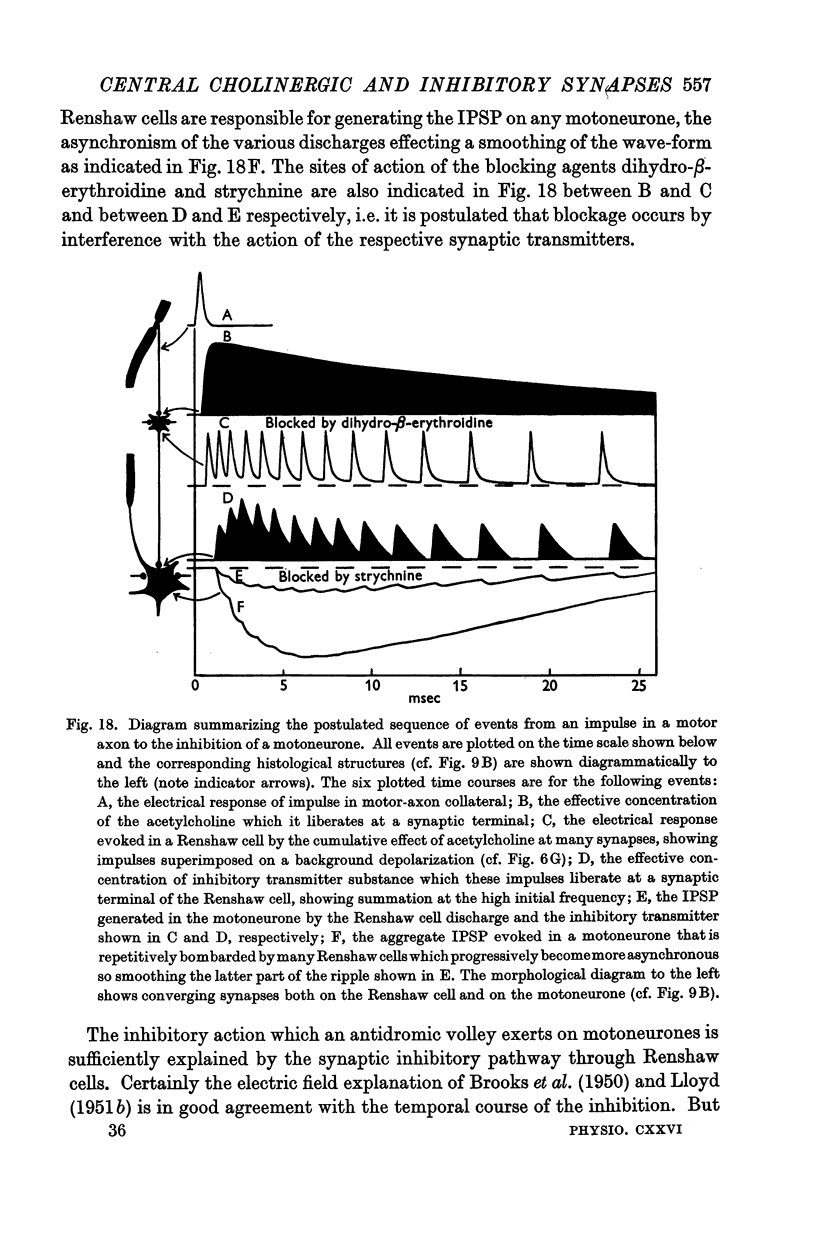Full text
PDF






































Selected References
These references are in PubMed. This may not be the complete list of references from this article.
- BALTHASAR K. Morphologie der spinalen Tibialis- und Peronaeus-Kerne bei der Katze; Topographie, Architektonik, Axon- und Dendritenverlauf der Motoneurone und Zwischen-neurone in den Segmenten L6-S2. Arch Psychiatr Nervenkr Z Gesamte Neurol Psychiatr. 1952;188(4):345–378. doi: 10.1007/BF00367982. [DOI] [PubMed] [Google Scholar]
- BARAKAN T. H., DOWNMAN C. B. B., ECCLES J. C. Electric potentials generated by antidromic volleys in quadriceps and hamstring motoneurons. J Neurophysiol. 1949 Nov;12(6):393–424. doi: 10.1152/jn.1949.12.6.393. [DOI] [PubMed] [Google Scholar]
- BRADLEY K., EASTON D. M., ECCLES J. C. An investigation of primary or direct inhibition. J Physiol. 1953 Dec 29;122(3):474–488. doi: 10.1113/jphysiol.1953.sp005015. [DOI] [PMC free article] [PubMed] [Google Scholar]
- BROCK L. G., COOMBS J. S., ECCLES J. C. Intracellular recording from antidromically activated motoneurones. J Physiol. 1953 Dec 29;122(3):429–461. doi: 10.1113/jphysiol.1953.sp005013. [DOI] [PMC free article] [PubMed] [Google Scholar]
- BROCK L. G., COOMBS J. S., ECCLES J. C. The recording of potentials from motoneurones with an intracellular electrode. J Physiol. 1952 Aug;117(4):431–460. doi: 10.1113/jphysiol.1952.sp004759. [DOI] [PMC free article] [PubMed] [Google Scholar]
- BROOKS C. M., DOWNMAN C. B. B., ECCLES J. C. After-potentials and excitability of spinal motoneurones following antidromic activation. J Neurophysiol. 1950 Jan;13(1):9–38. doi: 10.1152/jn.1950.13.1.9. [DOI] [PubMed] [Google Scholar]
- Bacq Z. M., Brown G. L. Pharmacological experiments on mammalian voluntary muscle, in relation to the theory of chemical transmission. J Physiol. 1937 Feb 19;89(1):45–60. doi: 10.1113/jphysiol.1937.sp003461. [DOI] [PMC free article] [PubMed] [Google Scholar]
- Brown T. G. On the nature of the fundamental activity of the nervous centres; together with an analysis of the conditioning of rhythmic activity in progression, and a theory of the evolution of function in the nervous system. J Physiol. 1914 Mar 31;48(1):18–46. doi: 10.1113/jphysiol.1914.sp001646. [DOI] [PMC free article] [PubMed] [Google Scholar]
- Cowan S. L. The action of eserine-like and curare-like substances on the responses of frog's nerve-muscle preparations to repetitive stimulation. J Physiol. 1938 Aug 15;93(3):215–262. doi: 10.1113/jphysiol.1938.sp003637. [DOI] [PMC free article] [PubMed] [Google Scholar]
- ECCLES J. C., FATT P., LANDGREN S., WINSBURY G. J. Spinal cord potentials generated by volleys in the large muscle afferents. J Physiol. 1954 Sep 28;125(3):590–606. doi: 10.1113/jphysiol.1954.sp005183. [DOI] [PMC free article] [PubMed] [Google Scholar]
- ECCLES J. C., RALL W. Effects induced in a monosynaptic reflex path by its activation. J Neurophysiol. 1951 Sep;14(5):353–376. doi: 10.1152/jn.1951.14.5.353. [DOI] [PubMed] [Google Scholar]
- FELDBERG W. Central excitation and inhibition from the view point of chemical transmission. Proc R Soc Lond B Biol Sci. 1952 Oct 16;140(899):199–202. doi: 10.1098/rspb.1952.0058. [DOI] [PubMed] [Google Scholar]
- FELDBERG W. The role of acetylcholine in the central nervous system. Br Med Bull. 1950;6(4):312–321. doi: 10.1093/oxfordjournals.bmb.a073622. [DOI] [PubMed] [Google Scholar]
- Gesell R. FORCES DRIVING THE RESPIRATORY ACT: A FUNDAMENTAL CONCEPT OF THE INTEGRATION OF MOTOR ACTIVITY. Science. 1940 Mar 8;91(2358):229–233. doi: 10.1126/science.91.2358.229. [DOI] [PubMed] [Google Scholar]
- HAGBARTH K. E., NAESS K. Reflex effects of tetanic stimulation of different afferent fibre-systems in the hind limb of the cat. Acta Physiol Scand. 1950 Dec;21(4):336–361. doi: 10.1111/j.1748-1716.1950.tb00742.x. [DOI] [PubMed] [Google Scholar]
- HOLMGREN B., MERTON P. A. Local feedback control of motoneurones. J Physiol. 1954 Feb 26;123(2):47–8P. [PubMed] [Google Scholar]
- HOLTON F. A., HOLTON P. The vasodilator activity of spinal roots. J Physiol. 1952 Nov;118(3):310–327. doi: 10.1113/jphysiol.1952.sp004796. [DOI] [PMC free article] [PubMed] [Google Scholar]
- LLOYD D. P. C. After-currents, after-potentials, excitability, and ventral root electrotonus in spinal motoneurons. J Gen Physiol. 1951 Nov;35(2):289–321. doi: 10.1085/jgp.35.2.289. [DOI] [PMC free article] [PubMed] [Google Scholar]
- LLOYD D. P. C. Electrical signs of impulse conduction in spinal motoneurons. J Gen Physiol. 1951 Nov;35(2):255–288. doi: 10.1085/jgp.35.2.255. [DOI] [PMC free article] [PubMed] [Google Scholar]
- LLOYD D. P. C. Electrotonus in dorsal nerve roots. Cold Spring Harb Symp Quant Biol. 1952;17:203–219. doi: 10.1101/sqb.1952.017.01.020. [DOI] [PubMed] [Google Scholar]
- LLOYD D. P. C. Post-tetanic potentiation of response in monosynaptic reflex pathways of the spinal cord. J Gen Physiol. 1949 Nov;33(2):147–170. doi: 10.1085/jgp.33.2.147. [DOI] [PMC free article] [PubMed] [Google Scholar]
- SPRAGUE J. M. Motor and propriospinal cells in the thoracic and lumbar ventral horn of the rhesus monkey. J Comp Neurol. 1951 Aug;95(1):103–123. doi: 10.1002/cne.900950107. [DOI] [PubMed] [Google Scholar]


